|
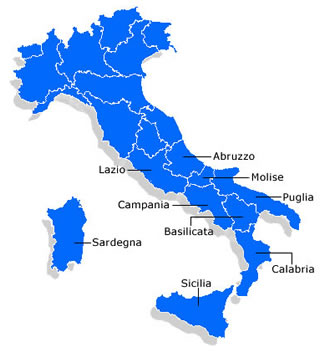 The Food of Southern Italy The Food of Southern Italy

Southern Italy has such a vast variety of traditional cuisine it seems almost everything you find in Central and Northern Italy can be found there. What stands out the most is pasta, pizza and bread making. The flour based main dishes are calzone, pizza and focaccia bread.
Most of the beef comes from the North because of the drier land that is inhospitable to grazing therefore beef, butter, and cream play a much less prominent role. Pigs, though, are a beloved beast and pork is used for cooking fat, sausages like mortadella, bacon or pancetta, ham, and a hundred others things.
The soil does nourish the olive tree and so southern cooking is oil-based, her sauces filled with the vegetables and seaood that are always nearby and don't want heavy creams to cover their flavors. Sardines and anchovies are prominent. Eel, shellfish, and other Mediterranean frutti di mare can be found cooked in wine, grilled over a fire, deep-fried, or tossed on pasta. Cheeses are made from the milks of all types of livestock, pigs excluded. Pecorino and ricotta, mozzarella, caciocavallo, and countless other cheeses are produced in Calabria and the other southern provinces.
As in other regions of southern Italy, pasta plays an important part in Sicilian cuisine, as does rice. Sicily produces some unique cheeses, such as pecorino (from sheep's milk) and caciocavallo (from sheep or cows). Popular spices include saffron, nutmeg, clove, pepper, and cinnamon, some of which were introduced by the Arabs. Meat dishes include goose, lamb, goat, rabbit, and turkey, which gained in popularity during the Norman and Hohenstaufen periods. Even the Greeks introduced varieties of olives and grape vines, and the Arabs brought oranges, lemons, pistachio and sugar cane.
Sicily is also famous for its sweets, ice creams and pastries. Cannoli, biancomangiare, biscotti ennesi, braccilatte, buccellato, ciarduna, pignoli, bruccellati, sesame seed cookies, cubbaita, frutta martorana, cassata, pignolata, granita and cuccìa are all Sicilian delicacies.
If you have information on Southern Italy, please share with us. If you have questions regarding this web page, please fill out our online contact form and it will be our pleasure to respond.
Information on Southern Italy
|
Campagnia - Southern Italy
|
| |
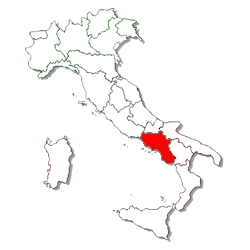 Campagnia - Southern Italy Campagnia - Southern Italy
The cuisine of Campagnia is famous throughout the world: spaghetti with tomatoes and basil, spaghetti all vongole, pizza topped with fresh mozzarella and eggplant parmigiana. As well as fresh mozzarella made from buffalo or cows milk, there is good ricotta, goat cheeses and caciocavall. Lemons are used in granita and limoncello.Central Italy (est. pop. 5,191,731) 5,249 sq mi (13,595 sq km) Located on the shin of Italy's boot, The cuisine of Campania and Naples is famous thoughout the world. Spaghetti with tomatoes and basil. Spaghetti Vongole. pizza topped with mozzarella, stuffed tomatoes and eggplant parmigiana. As well as fresh mozzarella made from buffalo or cow's milk, there is good ricotta, goat cheeses and caciocavallo. Lemons are used in granita and limoncello. Wherever you go in this region, Mt. Vesuvius casts a dramatic shadow over the fertile landscape. Thanks to the volcanic soil, Campania yields some of the best fruits and vegetables in Italy.
For more information on Campagnia click here →
|
|
| |
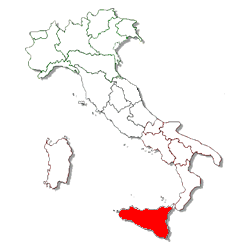 Sicily - Southern Italy Sicily - Southern Italy
The largest of the Mediterranean islands, Sicilia is home to spectacularly beautiful mountains and heavenly beaches, as well as Greek temples and Baroque churches. The Greeks, Phoenicians, Romans, Arabs, Normans, French, and Spaniards all marched across Sicilia at one time or another, and their influence is evident in the region's cooking style. The Greeks exerted their influence on the preparation of fish and vegetables. The Arabs brought eggplants, spinach, apricots, almonds, couscous and spices and showed the Sicilians how to preserve fish and fruit, as well as how to make some of the candies for which they're now famous. The Normans advanced Sicilian baking.
For more information on Sicily click here →
|
Calabria - Southern Italy
|
| |
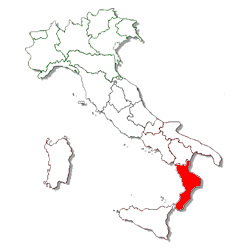 Calabria - Southern Italy Calabria - Southern Italy
Calabria has two coastlines, giving it plenty of seafood, particularly swordfish and tuna. Citrus fruit grow well here, as do figs and olives. Peperoncino adds fire to the cooking and there is excellent provolone and caciocavallo. Sicilian food has long been influenced by invaders, particularly the Arabs who brought sugar. The island's dolci (sweets), granite and gelati are still considered Italy's best. There is also an abundance of seafood, citrus fruit and capers for making caponata.Home to magnificent high, rugged mountains, Calabria is filled with snow until the end of May. Unlike neighboring Basilicata, Calabria has wooded areas where flowers bloom and wildlife and greenery abound. The region boasts some of the cleanest water on the whole Italian coastline due to the lack of pollutant development in the area. Chestnuts, olives, citrus trees, almonds, and figs all grow well in Calabria's subtropical climate. A species of orange that grows only in Calabria, called arancia calabrese, is prized for its skin, which is boiled and candied, and sent all over Italy for use in fruitcake and pastries.
For more information on Calabria click here →
|
|
| |
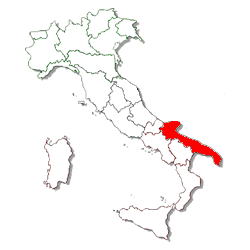 Puglia - Southern Italy Puglia - Southern Italy
Puglia has had many foreign invaders, but the food remains Italian. Orecchette is a delicious ear shaped past, served locally with cime di rapa (trunip greens) and good cheeses include caciocavallo, scamorza and pecorino. Puglia is adorned with a long, beautiful coast line, largely free of tourists and development. The heel and spur of Italy's boot produces hearty fruits and vegetables, a main addition of Puglian cuisine. Puglia's cuisine is fairly uniform, due to the friendly attitude in this flat country side. Relying on the same ingredients through out the region.
For more information on Puglia click here →
|
|
| |
 Lazio - Southern Italy Lazio - Southern Italy
Lazio is influenced by the unique food of its capital. Roman cuisine is not delicate and makes use of pasta, beans, artichokes, meat and its spaghetti al carbonara and bucatini all'amatriciana both include the local guanciale (cured peg's cheek). In rural Lazio, lamb is used often in dishes like abbacchio (milk fed baby lamb). Lazio's is the region comprised of farmland that surrounds Rome. Down the road is Rome, the city of love and food . The Romans believe in simplicity and using the simplest ingredients for their recipes. Gnocchi di Semolino, a large dumpling made from just semolina flour, milk and eggs, is a prime example, as is Rome's well-known egg drop soup, Stracciatella. The prefered foods of Rome are bread, cheese, olives, fresh vegetables, and pasta.
For more information on Lazio click here →
|
|
| |
 Abruzzi - Southern Italy Abruzzi - Southern Italy
Abruzzi is breathtaking. High snowy mountain peaks and beautiful blue sea with sandy beaches. The region's coastal areas enjoy a mild climate and the mountainous inland area is snow-covered much of the winter and very hot in the summer. Due to this hot and cold climate the geographical contrast shares two distinct cuisines: coastal and mountain. Although both are southern in style, coastal cuisine consists mostly of fish and mountain cuisine of pork, lamb and Porchetta (suckling pig) which is a specialty in the mountainous areas of Abruzzi, as is its prosciutto named Aquila.
For more information on Abruzzi click here →
|
|
| |
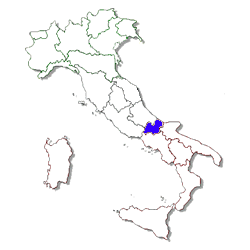 Molise - Southern Italy Molise - Southern Italy
For most Italians, Molise and Abruzzo are notably linked. This small, unyielding region facing the Adriatic only gained independence from Abruzzo in 1963. Molise is unique in that it is somewhat insulated from the changes that have overtaken the rest of the Italy. Bread, wine, and oil are staples of Molise cuisine. In fact, olive oil is the region's primary industry. Chili pepper is used liberally and often here, as it is in most other southern Italian regions. Very little meat is eaten in Molise; when it is, it's likely to be lamb or pork.
For more information on Molise click here →
|
Basilicata - Southern Italy
|
| |
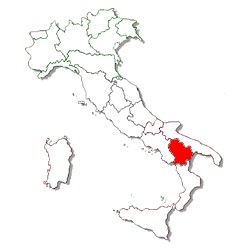 Basilicata - Southern Italy Basilicata - Southern Italy
Basilicata is one of the poorest regions of Italy, but it cucina povera, dominated by pasta and vegetables, can be delicious,. Dishes and meats are spiced with peperoncino.Southern Italy (est. pop. 600,000) 3,856 sq mi (9,987 sq km) Small and lowly populated, Basilicata lays between Campagna, Puglia, and Calabria at the upper heal of the Italian boot claiming a tiny bit coastland on the west and the Gulf of Taranto at its bottom edge. Most of the region's land is parched and dry, making Basilicata one of Italy's worst agricultural regions. The standard food staple is vegetables and pasta, with meat held for special occasions. Nearly every vegetable consumed in Italy is eaten in Basilicata, including local bitter onions, mushrooms, fava beans, artichokes, potatoes, and peppers. Peperonata is a local favorite consisting of sweet peppers, tomatoes and chili pepper, often mixed with chunks of pork. A custom in southern cooking is the liberal use of chili pepper.
For more information on Basilicata click here →
|
Sardegna - Southern Italy
|
| |
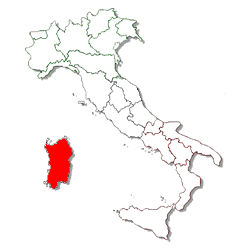 Sardegna - Southern Italy Sardegna - Southern Italy
Sardegnians have traditionally looked more to their inhospitable interior for food than to their once mosquito infested coast. The food is based on sucking pig and lamb, percorino, pane carsu (flat bread) and honey.Sardegna is the second largest island in the Mediterranean. Unlike other Mediterranean islands though, these inhabitants live in the island's mountains and not on the coast, in part due to the past when hiding from invaders that landed on the coast and to avoid the marshy coast that created the plague of malaria. Therefore, Sardegna has two distinct cuisines: coastal and inland. The coastal cuisine was influenced by invaders, who brought their ways of preparing the bounty of seafood available, including lobsters, which are rare elsewhere in Italy.
For more information on Sardegna click here →
|
Home | Advertising Information | Contact Us
Copyright ©2002 Italian Recipes Trinakria Development. All rights
reserved. |
 |
|
 |

 The Food of Southern Italy
The Food of Southern Italy Campagnia - Southern Italy
Campagnia - Southern Italy Sicily - Southern Italy
Sicily - Southern Italy Calabria - Southern Italy
Calabria - Southern Italy Puglia - Southern Italy
Puglia - Southern Italy Lazio - Southern Italy
Lazio - Southern Italy Abruzzi - Southern Italy
Abruzzi - Southern Italy Molise - Southern Italy
Molise - Southern Italy Basilicata - Southern Italy
Basilicata - Southern Italy Sardegna - Southern Italy
Sardegna - Southern Italy